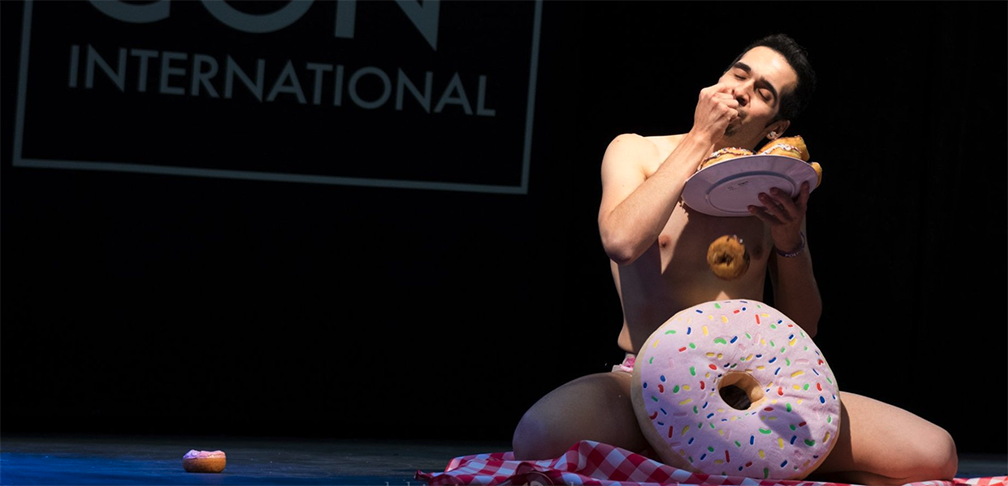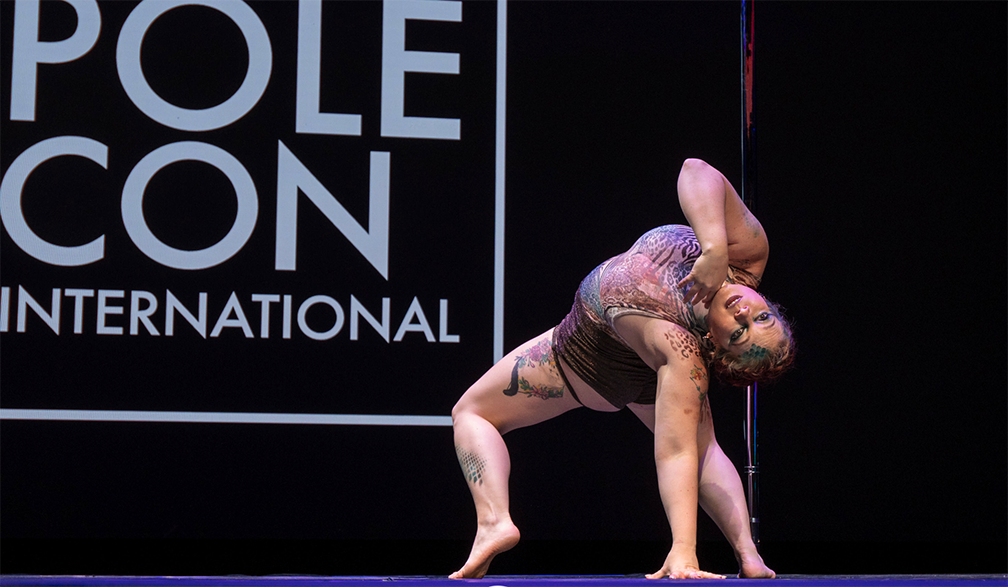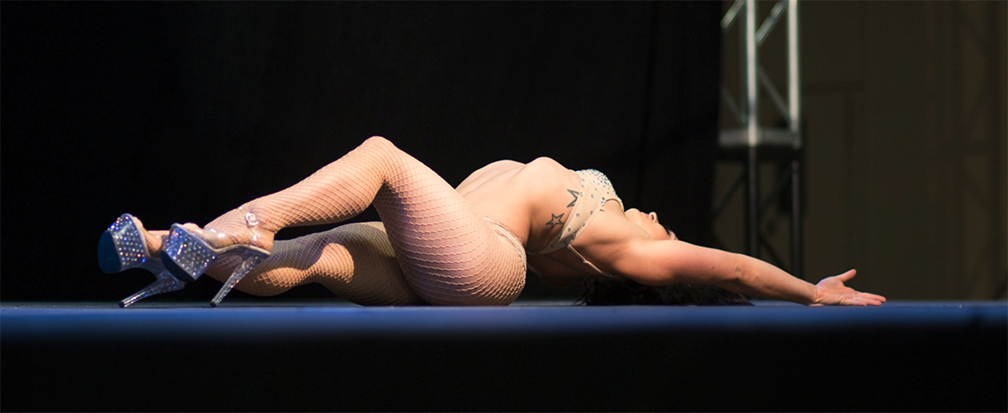We see a lot on social media about food trends, supplements, and “magic ingredients.” Influencers…

BECOMING A BEAST: 20 WAYS TO FIX YOUR INJURED, ACHY, OVERUSED POLE BODY
As a pole athlete, I spend most of my time either contorting myself into crazy shapes, throwing my body weight around in the air, teaching other people how to do these things, or thinking up new, even crazier ways that these things can be done. It’s awesome. There is absolutely nothing else I’d rather be doing. BUT. There’s one big drawback to doing all of this all the time, and that’s the toll that it takes on the body.
If I could be any superhero, I would be Wolverine. Can you imagine, just healing back from any bruise, cut, strain, or break instantaneously?! I can. It would be glorious. I could do ANYTHING. Pole for four hours straight, contort for three, and then go weightlifting and then rock climbing and then run out into the streets and jump from rooftop to rooftop doing parkour. Wake up and do it all again. No rest days ever!
Unfortunately, I’m not a mutant beast. In my past 4 years of poling, I’ve had a pretty wide spread of pole injuries: a torn meniscus that took me out for months and forced me to walk with a cane, intercostal strains that made it hurt to breathe, a reoccurring strained trapezius that caused constant neck pain, a sprained ankle, a strained hamstring, elbow tendinitis that I’m still battling… The list goes on. I’ve healed back from basically all of them (elbow tendinitis, you WILL be gone this year!), and this is how. Anyone who trains with me knows I always carry a bag of tricks with some unusual contraptions. So without further ado, here’s my list of 20 things to fix your injured, achy, overused pole body.
1. Epsom salt baths
My absolute #1 recovery method. Draw a bath as hot as you can comfortably stand, add in 1-2 cups of epsom salt, and soak for at least 20 minutes. The hot water by itself will start to relax your achy muscles, and your body will absorb magnesium from the epsom salts which does all kinds of good things: lowers stress levels, helps produce serotonin, reduces inflammation and pain, and improves sleep. Read more about the benefits of epsom salt here. In heavy training season I will take epsom salt baths almost every day.
2. Stretching
There are many kinds of stretching, and the kind we polers tend to think of most often is deep, intense stretching to increase range of motion. But that’s not what I’m talking about here. Contortion training tends to cause injuries and irritation when overdone, just like strength training. But gently stretching your overworked muscles helps them to calm and relax, and helps clear out buildups of lactic acid, which is what makes your muscles feel “sore”. Stretch before your workouts to warm up, after workouts to cool down, and in between workouts to keep loose and pain-free.
3. Foam rollers & hard balls
Once your achy muscles are calmed down and relaxing, it’s time to start working out the kinks and knots. Get rolling! This will feel less awesome than stretching and hot baths, but is incredibly important for working through injuries and breaking up scar tissue. If rolling on a specific muscle feels particularly tender and intense, then chances are you really need to be doing it. My favorite roller is the Rumble Roller, plus a racquetball for getting into smaller areas like behind the shoulderblade and in the hip flexor, and the Armaid for all the very cranky muscles in the forearms.
4. Heat pads
Chronic injuries need increased blood flow, and head pads are a way to keep that going all day. I’m a huge fan of these 12-hour stick-on pads. Stick them to your clothing, not your skin, so your skin can still breathe. I’ll wear them before workouts to increase mobility, especially if I’m doing contortion. And I’ll wear them during the day and/or when I sleep if an area is really stubbornly aching. (NOTE: Do NOT use heat therapy on a new injury that is swollen. If you have any swelling, heat will increase the swelling and you need to go for ice instead.)
5. T.E.N.S.
This stands for “Transcutaneous Electrical Nerve Stimulation.” This is often done in physical therapy offices. “TENS is thought to disrupt the pain cycle by delivering a different, non-painful sensation to the skin around the pain site. … Depending on the frequency the TENS unit delivers, the electrical stimulation can also trigger the body to release endorphins.” (Source here) I find this very helpful for muscle stiffness, especially on the low-back to recover from deep backbends in contortion training, and use this unit.
6. Massage
Professional massage does wonders in all of the departments an injured body needs: relaxing tight and spasming muscles, working out knots and kinks in the fascia, returning the body to proper alignment, increasing blood flow, and flushing out scar tissue. Yes, it’s expensive. But if you’re truly serious about being an athlete and suffer from chronic injuries, it may be essential to find a way to get this into your life. Find someone who understands working on athletes, and is willing to tailor your session to specifically the areas you need work on.
7. Acupuncture
In my experience, massage is best for overall maintenance of the body and muscle recovery, and acupuncture is best for very specific injuries, especially in your joints. Ligaments and tendons have poor blood flow, which is often why it’s so hard to heal injuries in the joints. Acupuncture will bring blood flow to those areas, and promote healing. It did wonders for my knee, elbow, and neck injuries. Like massage, it’s not cheap, but well worth it. My acupuncturist combines the needles with electrical stimulation, which is even more awesome for pain relief.
8. Sleep
The body rebuilds as we sleep. If you’re serious about trying to recover from hard workouts, it is absolutely essential that you get a full night of sleep, every night. No excuses. If you’re not sleeping enough, then no, you will not heal. It’s way less exciting than going to the gym, but just as important for making gains.
9. Nutrition
Like sleep, this is a piece of your lifestyle that you need to get serious about if you’re looking to improve recovery and healing. First off, you will want to give up (or at least cut back) alcohol consumption. Here’s a study to check out. “While injured athletes have been told to avoid alcohol for some time, we now have actual proof about why it is important to do so.” When it comes to your food, make sure you are getting enough nutrients – fresh fruit and veggies, lots of protein, and avoiding processed foods and refined sugar. Read this great blog post from Ellen Lovelace to learn more about nutrition for injuries!
10. Hydration
Last piece of the lifestyle talk – make sure you are drinking enough water! A hydrated body will function better and heal faster. Here’s another great post from Ellen here on the Pole Convention blog about the importance of hydration.
11. Avoid Overtraining
If you’re finding yourself injured all the time, you may want to reconsider the way you’re training. It probably isn’t working. Overtraining is detrimental rather than helpful. If the body isn’t given enough time to heal and recover between workouts, you will start losing ground rather than improving. A lot of us, myself included, just want to do MORE MORE MORE to get better at skills, but it doesn’t work that way. Getting good at pole is a marathon, not a sprint. Be patient. Stagger your workouts so you’re working different skills and muscle groups on different days. You shouldn’t pole every day — find something complimentary to cross train with. Don’t do the same thing two days in a row. Make sure you take 1 or two complete rest days off of everything each week.
12. Work Evenly: Do Both Sides
Any veteran poler can tell you the importance of working both sides when learning tricks. For one, when you start combining skills together, your repertoire will be way, way more useful if you can do everything on both sides, rather than having to come up with crazy involved transitions to get yourself over to your “good side.” But back to what this piece is about — a balanced body is a healthy body. The body is built to be symmetrical. When you only train one side, imbalances start to happen that set off a domino effect, creating extra pressure in certain areas, leading to pain and injury.
13. Topical Analgesics
Pain-relieving creams, ointments, and oils can be very helpful for pain relief in the recovery process. If they produce a warming effect, you may get some good increased blood flow that improves healing, but for the most part they just mask pain. Use carefully! If you’re using them to relieve pain and then going and working out and worsening an injury, it’s not worth it. You’re just drawing out the recovery process. Let yourself rest instead. My favorite is White Flower Oil for general achy muscles, and Bengay if I really need to warm up achy muscles before extreme stretching.
14. Advil
Like topical analgesics, be careful with Advil. Again, if you’re using it to relieve pain and then going and working out and worsening an injury, it’s not worth it! But it works really, really well for muscle aches and pains. And Ibuprofin has the added benefit of reducing swelling, so it actually does help improve healing time in new or swollen injuries.
15. Ice
I’m not in the camp that says ice all injuries. I side with Eastern medicine on this one, based on what’s worked for my own injuries. Heat improves blood flow (thus promoting healing), and cold reduces it. BUT. If an injury is new, within the past 24-72 hours, and/or swollen, you want to use ice and not heat. Ice will reduce the swelling, and get your body back to healing normally. Use ice together with Advil, a compression bandage, and elevating the injured area above your heart.
16. Arnica for Bruises
Compared to all the rest, I consider bruises a pretty minor issue. But sometimes you get a really awful one, or you just want to go out in public showing skin and look like a normal human. Topical Arnica will help speed healing time and get rid of the black and blue.
17. New-skin for Cuts
Again, cuts are a minor issue, but a small cut on an area that you really need for climbing, like on your finger, can suddenly feel like a really big deal when you get on the pole. I’m a fan of New-skin for protecting those cuts, keeping them covered and sealed, and still allowing you to get grip on the pole (unlike a bandaid). WARNING: I’ve heard bad things about using New-skin on an area of skin that has been rubbed off, rather than a clean slice kind of cut. It may slow down healing and cause more scarring than normal. Use this for cuts rather than scrapes or blisters.
18. Maintain your Calluses
Few things are as frustrating as a hand callus that rips. If this has ever happened to you, you know exactly what I mean. If it hasn’t, imagine a big painful blister right on the part of your hand that you need most for climbing. To keep your calluses from getting too thick and dry, which gives them the potential to rip or crack, file them down regularly. I also like to use Corn Husker’s Lotion on my hands at night sometimes, which works great for softening even the gnarliest of hands. For those of you who are deathly afraid of using lotion ever — I’ve actually seen Corn Husker’s used as a moistening pole grip aid, similar to Dew Point.
19. Tape & Support Braces
To aid an injury, taping up an area or wearing a brace can be very helpful. Especially if you have a sprain, this will give you added compression and reduce or prevent swelling. If you’re taping up your wrists, knees, or ankles, you can use electrical tape (rather than normal sports tape) so that area will still grip the pole something like bare skin. But like the use of pain relievers, be careful with this. Don’t tape yourself up just so you can go workout and do more damage to the area. At that point, you’re better off resting.
20. Rest & Time Off
And that brings me to #20 — everyone’s least favorite answer. If none of the above are working, it’s time to take some time off. I know. You can’t. You have to compete at this, or perform at that, and everyone around you is going to keep getting better while you are going to fall behind and be hopeless, and you are going to go completely crazy sitting around without pole as your outlet. I can’t say it’s not going to suck. It WILL suck. But poling with pain sucks worse, as what could have been a minor injury drags out into a chronic injury that slowly eats away at your skills and makes you more and more miserable, eventually leading to a very, very long period off the pole, or possibly leading you to quit altogether. Just suck it up and take a week or a few weeks off as soon as you get hurt. As the saying goes, a stitch in time saves nine. You will not lose all your skill or strength or flexibility. Muscle memory is an incredible thing, and you will be right back where you left off much sooner than you think.
*we do not own the rights to this image
Latest posts by Liz Kinnmark (see all)
- We’re Here, We’re Queer, & We’re Never Gonna Leave! - May 24, 2019
- TOP 10 WORKSHOPS FOR THE BEGINNER POLE DANCER - May 13, 2017
- 5 THINGS YOGIS DO BETTER THAN POLE DANCERS - September 23, 2016
This Post Has 3 Comments
Comments are closed.



[…] https://poleconvention.com/injury-prevention/becoming-a-beast-20-ways-to-fix-your-injured-achy-o… […]
Hi!! This post was so helpful. I am going to incorporate your suggestions. I’ve been pole dancing for about 7 months and I LOVE it! Unfortunately, I believe i pulled an intercostal muscle last week (I felt the moment when it happened in class). It’s pretty painful and doesn’t seem to be getting better. You mentioned having had this injury. Do you recall how long it took to heal? Thanks! Xx Julie
Thanks Julie! Yes, a strained intercostal is unfortunately one of the most painful pole injuries, and doesn’t heal quickly because you move your ribs every time you breathe. You’re looking at 6-8 weeks to recovery. Be very careful with it and and do everything you can to avoid twisting your torso. Good news is it can definitely heal back all the way – mine hasn’t been irritated since.